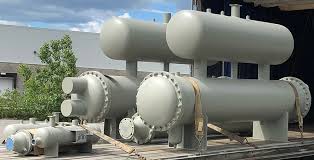Introduction
Flooded chiller evaporators are a pivotal component of modern cooling systems, offering unparalleled efficiency in heat transfer. Unlike traditional evaporators, where refrigerant only partially fills the heat exchange tubes, flooded evaporators are specifically designed to submerge the tubes entirely in liquid refrigerant. This design ensures constant and complete contact between the refrigerant and the tubes, significantly improving heat absorption and overall system performance. Flooded evaporators are widely adopted in industries such as food processing, pharmaceuticals, petrochemicals, and HVAC systems, where precise temperature control is crucial. Their ability to deliver consistent cooling performance under varying load conditions makes them a preferred choice for high-capacity and energy-efficient operations. However, their advanced design requires higher refrigerant volumes and meticulous maintenance, making them suitable for applications where performance and reliability outweigh the costs.
Key Features of Flooded Chiller Evaporators
- Enhanced Heat Transfer Efficiency
- In a flooded evaporator, the tubes are completely submerged in liquid refrigerant. This full contact between the refrigerant and heat transfer surfaces ensures that heat is efficiently removed from the fluid being cooled.
- This mechanism allows flooded evaporators to achieve significantly higher heat transfer rates compared to dry-expansion systems, where refrigerant only partially fills the tubes.
- Uniform Cooling Performance
- The consistent immersion of tubes in refrigerant eliminates hotspots or dry areas that could reduce cooling efficiency.
- This uniform heat transfer ensures that the desired cooling temperature is maintained across the entire evaporator, critical for processes requiring precise temperature control.
- Reduced Refrigerant Flow Issues
- By maintaining an excess of refrigerant, the evaporator prevents issues like refrigerant starvation, which can occur in other types of evaporators if flow rates are inconsistent.
- This design enhances system reliability, ensuring smooth operation even under varying load conditions.
- Wide Application Range
- Flooded evaporators are versatile and suitable for a variety of industries, including food processing, where precise cooling ensures product quality, and pharmaceuticals, where temperature-sensitive materials must be handled carefully.
How Flooded Evaporators Work
- Refrigerant Supply
- Liquid refrigerant is introduced into the shell of the evaporator, where it fills the chamber and fully submerges the tubes carrying the fluid to be cooled.
- Heat Absorption
- As the fluid flows through the tubes, the refrigerant absorbs the heat from the tube walls. This heat transfer causes the refrigerant to boil, transitioning it into a vapor state.
- Vaporization
- The heat absorbed from the fluid causes the refrigerant to vaporize uniformly across the surface area of the tubes, ensuring efficient energy transfer.
- Separation
- The vaporized refrigerant is separated from the remaining liquid refrigerant using a separator. This prevents liquid refrigerant from reaching the compressor, which could cause operational damage.
Advantages of Flooded Chiller Evaporators
- High Efficiency
- The constant contact between the refrigerant and the heat transfer surfaces leads to maximum heat absorption, reducing energy consumption and operational costs.
- Reliability
- By eliminating dry spots and ensuring consistent refrigerant levels, flooded evaporators offer improved reliability and longer equipment lifespan.
- Flexibility
- Flooded evaporators are adaptable to a variety of applications, especially those requiring precise temperature control or operating in low-temperature environments.
- Improved Capacity
- The design allows these evaporators to handle larger cooling loads efficiently, making them ideal for heavy-duty industrial and commercial applications.
Challenges of Flooded Chiller Evaporators
- Higher Initial Cost
- The advanced design and components, such as the separator and larger shell size, contribute to higher upfront costs compared to simpler evaporator types.
- Increased Refrigerant Requirement
- Flooded evaporators require a larger volume of refrigerant to maintain full immersion, which increases the initial and ongoing operational expenses.
- Complex Maintenance
- Regular cleaning, refrigerant handling, and tube inspections can be challenging due to the intricate design, requiring skilled technicians and specialized tools.
Applications
- Process Cooling
- Flooded evaporators are commonly used in industries like petrochemicals and chemical processing, where precise temperature control is essential for maintaining process stability and product quality.
- HVAC Systems
- In large commercial and industrial buildings, flooded evaporators help maintain consistent indoor temperatures and air quality by supporting centralized HVAC systems.
- Refrigeration
- Low-temperature storage facilities, ice rinks, and cold chain logistics rely on flooded evaporators for their efficiency and ability to maintain stable temperatures.
Conclusion
Flooded chiller evaporators represent a sophisticated and effective approach to modern cooling challenges. Their unique design, characterized by the full immersion of heat exchange tubes in refrigerant, ensures unmatched heat transfer efficiency and consistent performance. This makes them ideal for critical applications that demand precision, reliability, and high-capacity cooling. While the initial investment and maintenance complexity may be higher than simpler evaporator designs, the long-term benefits—such as improved energy efficiency, reduced operational risks, and adaptability to various industries—justify the costs. Flooded evaporators are not only a technical solution but also an essential asset for businesses prioritizing sustainable and efficient cooling systems. As industries advance and environmental concerns push for better energy utilization, flooded chiller evaporators will continue to play a significant role in driving innovation in cooling technologies. Their contribution to efficiency, productivity, and sustainability underscores their importance in both current and future industrial applications.

